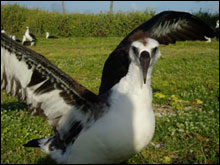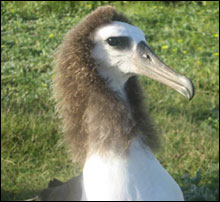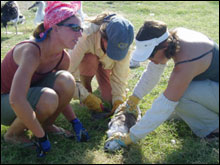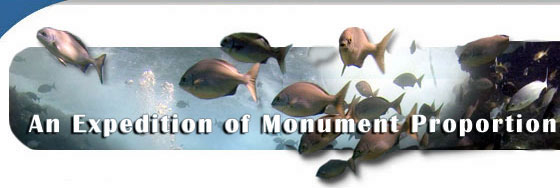|
Mission Log: July 2, 2006
Legs of Steel...Bird Banding on Green Island
Dena Deck
NOAA Teacher-at-Sea
Early the sun arose, with our group preparing to band Laysan Albatross on Green Island in the ring of Kure Atoll. Cynthia Vanderlip, Dept. of Land and Natural Resources Field Camp Leader along with Jacob Eijzenga a Fish and Wildlife Service biologist, and his wife Heather a volunteer, instructed our group in the proper protocol for banding fledgling albatross.
The chicks were hatched in January. Their parents are diligent caregivers, with both doting parents providing endless warmth to their single egg. The caregivers balance the egg on the tops of their feet and tucked in the brood patch to keep it warm.
 |
| A Laysan Albatross fledgling practices how to take flight. (Photo: Claire Johnson/NOAA) |
The chick hatchling arrives, and the parents start the long and tedious job of feeding their down covered chick. Both parents contribute countless hours of flight time to collecting meals for their young. Unknowing they will likely return with a gullet full of misplaced plastics that may cause a slow and painful death, providing little nutrients to the young chick. Albatross mortality is higher when the chicks are younger. There are various reasons, one being that they may have lost a parent and aren’t getting enough nutrition or their nest cup is too deep in a shrub that the parent has a hard time relocating them to feed. Albatross chicks also succumb to heat, dehydration or a failure to digest food due to the ingestion of plastics. Parents looking for their chicks in the dense, alien verbesina plants may succumb to the heat, leaving the chick with just one parent to care for it to fledging. Generally, the parents locate their chick by the high-pitched squawking sounds and whining whistles. The chicks do some bill clacking and foot stomping while waiting up to two weeks for food delivery.
As we walked in single file to the banding area, our path was alive with young albatross fledglings holding wings out that would soon find their way to the sky. The young chicks accepted our group into their flight training area. They seemed to be interested in objects as we set up to band. I set my wide brimmed hat on the ground and set to capture a bird for banding. When I went to recover my hat, one of the inquisitive chicks was playfully pulling at the brightly colored band around my hat. After he lost interest I donned my gloves and began to team up to accomplish the morning’s task.
 |
| One of the many "hair-dos" of the Laysan Albatross chicks. We call this one the Abe Lincoln. (Photo: Paulo Maurin) |
Each albatross personality is augmented by the down wear off, almost a haircut of sorts. The Abe Lincoln look or the Mohawk cut is fashionable. We laughed as we walked down the old paved airstrip of the island. Cameras were clicking continuously for over two hours of our evening stroll.
The bands are now made of stainless steel, identified by number, and logged with a facility in Maryland. The stainless steel is expected to last at least 40 years, which should provide some good data over a long period of time. In conversation, Cynthia commented to us that maybe the longline fishermen would believe that these birds were of a greater value if someone had taken the time to band them.
Laysan Albatross are very tame, seemingly heedless. To band you must quickly take your left hand to the bird’s head, while your right hand frames the wings. A gentle hold will keep the bird docile for another team member to band the right leg. The birds need to be held with great care as to not damage the primary and secondary under wing feathers. In some instances, their feathers get a little ruffled, but nothing they can’t shake out easily.
 |
| Claire practices her technique of bird banding on Green Island. (Photo: Patricia Greene) |
On this particular day, we successfully banded 93 Laysan albatross. Each bird having its own attitude when the banding was complete. Some walking away unfazed, others lounging aggressively, clapping their beak. The Kure Atoll team plans to band nearly 300 Laysan Albatross this season on this particular area of the island. That way they have a small plot they can track the return of the albatross over time. Before our arrival, they had banded over 2,000 Black-footed Albatross before they fledged. Apparently the Black-footed Albatross are more feisty and put up a bigger fight when getting banded. We weren’t nearly as challenged with the somewhat docile Laysan Albatross.
The importance of banding birds helps us understand migration patterns and the longevity of the species. Cynthia believes that the albatross, the largest of the seabirds, live between 40-50 years and possibly even to 60 years old. From previous banding efforts we also now know that Laysan Albatross are a species that mate for life.
It is truly an open ocean bird with a mastery of gliding flight. They rarely approach land, only to breed on isolated, remote islands, such as Green Island in Kure Atoll. The fledglings will return in 4 years to the same location or within meters of their original nest cup, which is where they were born. At four years of age albatross are able to mate, but have little success. However, by the age of seven, the success rate increases with viable eggs.
After our banding activity, we pulled out some of the invasive verbesina weeds to clear a “runway” for the fledglings. The greatest joy of this activity was seeing my banded bird attempt to take flight. Somehow it seems right to have a full runway left on Green Island by the Coast Guard in 1992. It serves as “real” flight training site for the albatross.
|



